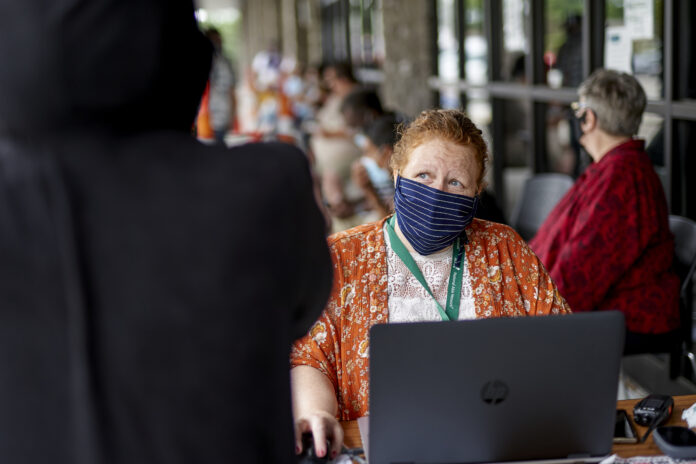
President Donald Trump’s plan to offer a stripped-down boost in unemployment benefits to millions of Americans amid the coronavirus outbreak has found little traction among the states, which would have to pay one-quarter of the cost to deliver the maximum benefit.
An Associated Press survey finds that as of Monday, 17 states have said they will take the federal grants allowing them to increase unemployment checks by $300 or $400 a week. The AP tally shows that 32 states have said they’re still evaluating the offer or have not said whether they plan to accept the president’s slimmed-down benefits.
The uncertainty is putting some families’ finances in peril.
Tiana Chase, who runs a community game room and store in Maynard, Mass., said the extra $600 she and her partner had been receiving under the previous federal benefit helped keep them afloat after the pandemic caused many businesses to shutter.
For the past few weeks, she’s been getting less than $300 in unemployment. If that’s boosted by another $300, “it’s going to be a lot tighter, but at least I can vaguely manage,” she said. “I can cover my home expenses.”
Many governors say the costs to states to receive the bigger boost offered by Trump is more than their battered budgets can bear. They also say the federal government’s guidelines on how it will work are too murky. Pennsylvania Gov. Tom Wolf, a Democrat, called it a “convoluted, temporary, half-baked concept [that] has left many states, including Pennsylvania, with more questions.”
New Mexico was the first state to apply for the aid last week and one of the first to be announced as a recipient by the Federal Emergency Management Agency. But Bill McCamley, secretary of the state’s Department of Workforce Solutions, said it’s not clear when the money will start going out, largely because the state needs to reprogram benefit distribution systems to make it work.
“People need help and they need it right now,” McCamley said. “These dollars are so important, not only to the claimants, but because the claimants turn that money around, sometimes immediately to pay for things like rent, child care, utilities.”
In March, Congress approved a series of emergency changes to the nation’s unemployment insurance system, which is run by state governments.
People who were out of work got an extra federally funded $600 a week, largely because the abrupt recession made finding another job so difficult. The boost expired at the end of July, and recipients have now gone without it for up to three weeks.
With Democrats, Republicans and Trump so far unable to agree to a broader new coronavirus relief plan, the president signed an executive order Aug. 8 to extend the added weekly benefit, but cut it to $300 or $400 a week, depending on which plan governors choose. States are required to chip in $100 per claimant to be able to send out the higher amount, something few have agreed to do, according to the AP tally.
Trump’s executive order keeps the program in place until late December, though it will be scrapped if Congress comes up with a different program. It also will end early if the money for the program is depleted, which is likely to happen within a few months.
Governors from both parties have been pushing for Congress to make a deal, even after previous talks for a sweeping new coronavirus relief bill, including an unemployment boost, broke off earlier this month.
When Congress finally reaches an agreement, “I have every reason to believe … there will be a more robust deal that is struck,” said Texas Gov. Greg Abbott, a Republican who has been noncommittal about accepting Trump’s plan.
One reason for the states’ hesitancy is that they fear they will go through the complex steps required to adopt Trump’s plan, only to have it usurped by one from Congress, according to a spokeswoman for Republican Wyoming Gov. Mark Gordon.
So far, most states that have said they are taking Trump up on his offer have chosen the $300 version. Some have not decided which plan to take. In North Carolina, for instance, Democratic Gov. Roy Cooper has pushed for the $400 plan, but Republican lawmakers have not committed to kick in a share of state money for that.
Mississippi’s Republican Gov. Tate Reeves has spurned the deal altogether, saying it’s too expensive.
State leaders who say they can’t afford to chip in point to the widespread closure of businesses, which has hammered government tax revenue. But they also acknowledge that they need the help, as a record number of claims have left their unemployment trust funds in rough shape.
Most states expect to exhaust their funds and need federal loans to keep paying benefits during the recession. So far, 10 states plus the U.S. Virgin Islands have done so, including California, which has borrowed $8.6 billion. Another eight states have received authorization for loans but had not used them as of last week.
California Gov. Gavin Newsom, a Democrat, is among governors who are critical of Trump’s approach but decided to take the deal anyway. “As I say, don’t look a gift horse in the mouth,” Newsom said last week.
Last week, the federal Department of Labor reported that 963,000 people applied for unemployment benefits for the first time. It was the first time since March that the number dropped below 1 million. The government says more than 28 million people are receiving some kind of unemployment benefit, although that figure includes some double counting as it combines counts from multiple programs.
State unemployment benefits on their own generally fall far short of replacing a laid off worker’s previous income.
Chris Wade, who lives in the Chicago suburb of Schaumburg, is a server at a high-end restaurant. He was laid off in March when dine-in restaurants were closed in the state. While he’s since returned, he’s working only a few shifts a week and his unemployment checks are reduced by the amount he’s paid.
The now-expired $600 weekly unemployment supplement came out to about the same as his family’s rent, he said. When his first check came in April, he was eight days behind on rent, but with the help, he’s been able to keep paying since then.
“The extra money, no matter what they give me, is all going to rent anyway, or other bills,” said Wade, 45. “Every dollar actually counts.”
(Distributed by The Associated Press)











